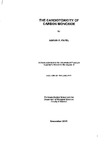THE CARDIOTOXICITY OF CARBON MONOXIDE
| dc.contributor.author | PATEL, ASHVIN P. | |
| dc.contributor.other | Peninsula Medical School | en_US |
| dc.date.accessioned | 2013-09-13T10:36:57Z | |
| dc.date.available | 2013-09-13T10:36:57Z | |
| dc.date.issued | 2003 | |
| dc.identifier | NOT AVAILABLE | en_US |
| dc.identifier.uri | http://hdl.handle.net/10026.1/1691 | |
| dc.description.abstract |
The mechanism(s) responsible for the cardiotoxicity of CO are not clear and do not appear to arise solely from tissue hypoxia. Tissue hypoxia is produced by CO binding to haemoglobin and reducing the amount of oxygen carried by the blood in vivo. CO-induced hypoxia in vivo may be responsible for producing conditions such as those found during ischaemia/reperfusion (l/R) injury. Reactive oxygen species (ROS) produced during l/R injury is established and responsible for cellular/tissue damage from the oxidative damage. We postulate that oxidative stress is responsible for the CO-associated cardiac morbidities found in some cases following severe acute exposure to CO. Isolated perfused rat hearts were used to investigate the physiological and biochemical changes in hearts following CO exposure. Hearts were perfused with buffer equilibrated with different mixtures of CO (0-0.05% CO for 30 minutes) in the presence of 21% oxygen during and after CO exposure (for 90 minutes), i.e. normoxic conditions were used throughout. Some hearts were perfused with water-soluble antioxidants (ascorbic acid and TroloxC) before and during the CO exposure. The reduced heart rate and perfusate flow suggest that CO may have a direct effect in heart tissue. Biochemical measurements suggest that no tissue hypoxia occurred under these conditions. The results provide evidence to suggest that oxidative stress occurred in ventricle tissue after CO exposure and was attenuated by the antioxidants. However, isolated rat liver mitochondria exposed to CO and/or hyperoxia showed no ROS production suggesting that mitochondria may not be a source of the oxidative stress. CO exposure may also produce altered myocardial energetics by oxidatively modifying and/or binding to myoglobin. Tissue damage initiated by CO-induced oxidative stress and hypoxia may potentiate ageing within heart tissue in vivo and could be responsible for producing the observed CO-associated heart morbidity in an MR-like injury. | en_US |
| dc.language.iso | en | en_US |
| dc.publisher | University of Plymouth | en_US |
| dc.title | THE CARDIOTOXICITY OF CARBON MONOXIDE | en_US |
| dc.type | Thesis | |
| plymouth.version | Full version | en_US |
| dc.identifier.doi | http://dx.doi.org/10.24382/3897 | |
| dc.identifier.doi | http://dx.doi.org/10.24382/3897 |
Files in this item
This item appears in the following Collection(s)
-
01 Research Theses Main Collection
Research Theses Main


